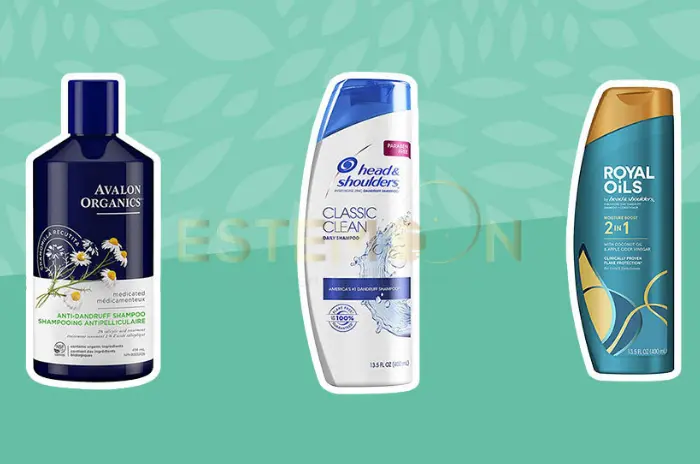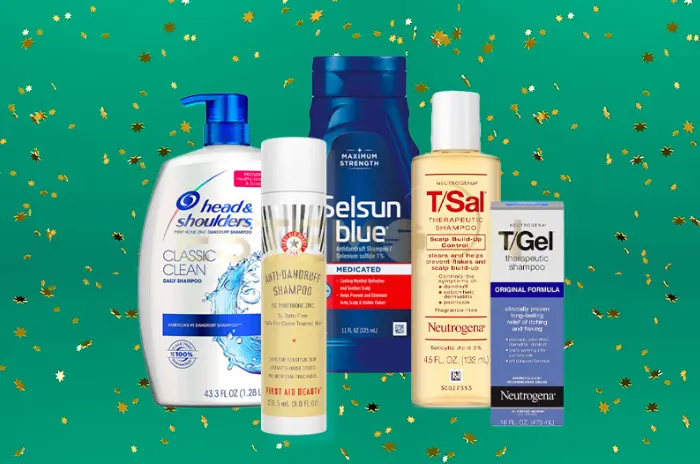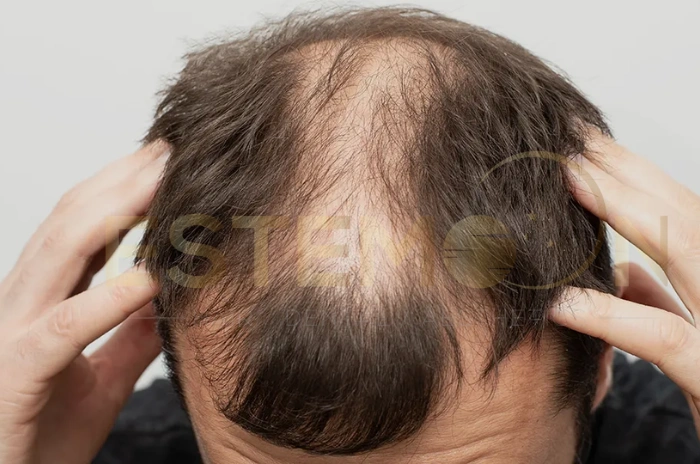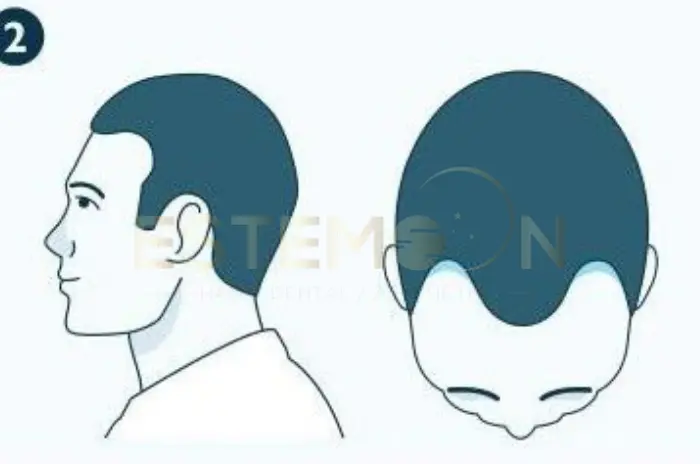Dandruff affects nearly half of the global population, making it one of the most common scalp conditions. Many people struggle to find effective treatment solutions, often cycling through products without lasting relief. The key to successful dandruff management lies in selecting the appropriate anti-dandruff shampoo formulation.
At Estemoon, we understand that choosing the right anti-dandruff shampoo can be overwhelming. Each formulation targets different aspects of dandruff formation, from fungal overgrowth to oil production and inflammation. Effectiveness depends on matching active ingredients to your specific dandruff type and severity.

What Dandruff Is and Common Symptoms to Look For
Dandruff is a scalp condition characterized by excessive shedding of dead skin cells, resulting in visible flakes on hair and shoulders. This occurs when the normal skin renewal process accelerates, causing cells to shed faster than they can be naturally removed.
Primary Causes:
- Malassezia overgrowth: Fungus feeds on scalp oils producing irritating byproducts
- Seborrheic dermatitis: Inflammatory condition affecting oil-rich body areas
- Dry skin: Common in cold, dry climates
- Product sensitivity: Contact dermatitis from harsh chemicals
- Hormonal changes: Fluctuations during puberty, pregnancy, or stress
Common Symptoms:
- White or yellowish flakes on scalp and shoulders
- Scalp itching ranging from mild to severe
- Redness and inflammation in affected areas
- Scalp tightness or burning sensations
- Greasy or dry patches depending on type
Understanding the Common Causes of Dandruff and Itchy Scalp
Malassezia fungus stands as the primary culprit behind most dandruff cases. This naturally occurring yeast lives on everyone’s scalp, feeding on the oils produced by hair follicles. When Malassezia overgrows, it breaks down scalp oils into oleic acid, triggering inflammation and accelerated skin cell turnover that creates those troublesome flakes.
Seborrheic dermatitis represents a more severe form of dandruff affecting areas rich in oil glands. This inflammatory condition causes red, scaly patches on the scalp, face, and other body parts. The oily irritated scalp becomes inflamed, producing thick, yellowish scales.
Individual risk factors for dandruff include age, gender, and genetics. Men experience dandruff more frequently than women, likely due to higher sebum production. The condition typically begins during teenage years when hormone levels fluctuate.
Environmental factors also contribute significantly to dandruff causes. Cold, dry weather strips moisture from the scalp, while indoor heating systems create additional dryness. Conversely, hot, humid conditions can increase oil production, feeding Malassezia growth.
Certain medical conditions increase susceptibility to dandruff. Psoriasis and eczema affect skin cell turnover rates, potentially triggering dandruff-like symptoms. Neurological conditions such as Parkinson’s disease correlate with increased seborrheic dermatitis rates.
Key Differences Between Dandruff and Dry Scalp
Dry scalp and dandruff share similar symptoms but require different treatment approaches. Dry scalp results from insufficient moisture, producing small, white flakes without significant inflammation. The scalp appears tight and feels rough to the touch, especially after washing.
Dandruff involves Malassezia fungus activity and inflammation, creating larger, oilier flakes that may appear yellowish. The itchy scalp typically feels more intense with dandruff, and symptoms worsen with infrequent washing.
Seasonal patterns help distinguish between these conditions. Dry scalp worsens during winter months when humidity drops. Dandruff may improve in dry conditions but often persists year-round.
Response to moisturizing treatments provides another diagnostic clue. Dry scalp improves with regular conditioning treatments. Dandruff typically worsens with heavy conditioning products that feed Malassezia growth.
The scalp’s overall appearance differs significantly. Dry scalp looks flaky but maintains normal color, while dandruff often presents with redness and greasy-looking scales.
Effective Dandruff Treatment with Medicated Shampoo
Dandruff shampoo containing active ingredients provides the most reliable dandruff treatment approach. Zinc pyrithione shampoos work by controlling Malassezia growth while reducing inflammation. This gentle yet effective ingredient suits most people, including those with sensitive scalps.
Selenium sulfide offers another powerful option for how to get rid of dandruff. This ingredient slows skin cell turnover while fighting fungal infection. However, selenium sulfide can cause scalp irritation in some users and may lighten chemically treated or gray hair with prolonged use.
Ketoconazole represents the strongest over-the-counter antifungal option available in dandruff shampoo formulations. This prescription-strength ingredient effectively targets Malassezia fungus while reducing inflammation associated with seborrheic dermatitis. Ketoconazole works particularly well for severe or persistent cases.
Coal tar shampoos help treat dandruff by slowing skin cell production and reducing inflammation. While effective for scalp psoriasis and severe dandruff, coal tar products may cause photosensitivity and have a strong odor that some users find unpleasant.
| Active Ingredient | How It Works | Best For | Usage Frequency |
|---|---|---|---|
| Zinc Pyrithione | Controls Malassezia growth, reduces inflammation | Most dandruff types, sensitive scalps | 2-3 times weekly |
| Selenium Sulfide | Slows skin cell turnover, fights fungal infection | Oily scalp, persistent dandruff | 1-2 times weekly |
| Ketoconazole | Strong antifungal action against Malassezia | Seborrheic dermatitis, severe cases | 2 times weekly |
| Coal Tar | Slows skin cell production, reduces inflammation | Scalp psoriasis, thick scales | 1-2 times weekly |
| Salicylic Acid | Removes scales, dissolves dead skin bonds | Thick, stubborn dandruff flakes | 2-3 times weekly |
Proper application technique maximizes dandruff treatment effectiveness. Apply dandruff shampoo to wet hair, massage gently into the scalp, and leave on for several minutes before rinsing. Follow package directions for frequency, typically starting with daily use before reducing to maintenance levels.
How Anti Dandruff Shampoo Works to Treat Flakes
Anti-dandruff shampoos address multiple factors contributing to flake formation through several mechanisms:
Antifungal Action: Targets Malassezia fungus with ingredients like ketoconazole, selenium sulfide, and zinc pyrithione that reduce fungal populations and associated irritation.
Keratolytic Effects: Ingredients like salicylic acid break down protein bonds holding dead skin cells together, making flakes easier to remove during washing.
Anti-inflammatory Properties: Reduces inflammatory responses that contribute to accelerated skin cell turnover and excessive flaking.
Oil Control: Balances thorough cleansing with scalp health maintenance, removing excess oils without over-drying.
Anti Dandruff Shampoo at a Glance
Understanding key components helps make informed selection decisions.
Active Ingredients:
- Ketoconazole: Potent antifungal for persistent cases
- Zinc pyrithione: Broad-spectrum antimicrobial with anti-inflammatory effects
- Salicylic acid: Dissolves scale buildup effectively
- Selenium sulfide: Combines antifungal and keratolytic benefits
- Coal tar: Traditional ingredient with multiple mechanisms
Product Categories:
- Daily use formulas for maintenance
- Treatment shampoos for active management
- Combination products addressing multiple concerns
| Active Ingredient | Primary Action | Usage Frequency |
|---|---|---|
| Ketoconazole | Antifungal | 2-3 times/week |
| Zinc Pyrithione | Antimicrobial/Anti-inflammatory | Daily to alternate days |
| Salicylic Acid | Keratolytic | 2-3 times/week |
| Selenium Sulfide | Antifungal/Keratolytic | 2 times/week |

How to Choose the Best Dandruff Shampoo for Your Needs
Selection requires considering your specific scalp condition, hair type, and individual factors.
Assess Your Dandruff Type: Oily, yellowish flakes often indicate seborrheic dermatitis responding well to antifungal ingredients. Dry, white flakes may benefit more from keratolytic agents like salicylic acid.
Hair Type Considerations:
- Oily hair: Can handle stronger formulations and frequent use
- Dry/treated hair: Requires gentler formulations with conditioning agents
- Color-treated hair: Needs sulfate-free options
- Fine hair: Benefits from lightweight formulations
Additional Factors:
- Start with lower concentrations for sensitive skin
- Consider washing frequency preferences
- Account for environmental exposure levels
- Evaluate lifestyle and stress factors
For persistent cases, intermediary organizations can help identify underlying causes and recommend appropriate treatments.
Top Recommended Dandruff Shampoos for Immediate Relief
For Seborrheic Dermatitis: Ketoconazole-based shampoos provide strongest antifungal action for persistent, oily dandruff with rapid relief potential.
For Mild-Moderate Dandruff: Zinc pyrithione shampoos offer balanced effectiveness and gentleness suitable for regular use across most hair types.
For Scale Buildup: Salicylic acid formulations excel at removing stubborn accumulated scales and work well in rotation with other treatments.
For Sensitive Scalps: Gentle formulations with lower active ingredient concentrations, often including soothing agents like aloe vera or chamomile.
Selection Criteria: Consider ingredient concentration, additional beneficial components, absence of known irritants, clinical testing evidence, and user feedback from similar scalp types.
How to Use Dandruff Shampoo for the Best Results
Proper application technique significantly impacts treatment effectiveness.
Application Process:
- Preparation: Brush hair thoroughly, wet completely with warm water
- Application: Use adequate amounts, focus on scalp, massage gently with fingertips
- Contact time: Allow 3-5 minutes for active ingredients to work
- Thorough rinsing: Remove all residue to prevent buildup
Usage Guidelines:
- Initial treatment: Daily use until symptoms improve (2-4 weeks)
- Maintenance phase: Reduce to 2-3 times weekly once controlled
- Progress monitoring: Allow 4-6 weeks for complete effectiveness evaluation
Avoid Common Mistakes:
- Insufficient contact time reduces ingredient effectiveness
- Over-washing can irritate scalp and worsen symptoms
- Frequent product switching prevents proper assessment
| Usage Phase | Frequency | Expected Results |
|---|---|---|
| Initial Treatment | Daily | Significant flake reduction |
| Maintenance | 2-3 times/week | Ongoing symptom control |
The Role of Diet and Stress Management in Dandruff Control
Nutritional factors influence scalp health and dandruff susceptibility significantly. Zinc deficiency correlates with increased dandruff symptoms, as this mineral plays crucial roles in skin cell production. Include zinc-rich foods like oysters, beef, and pumpkin seeds.
B-vitamin complex, particularly biotin and B6, supports healthy skin cell turnover and reduces inflammation. Leafy greens, eggs, and whole grains provide excellent sources of these essential nutrients.
Omega-3 fatty acids help reduce inflammation throughout the body, including the scalp. Regular consumption of fatty fish, walnuts, and flaxseeds may help manage dandruff symptoms while supporting skin health.
Chronic stress triggers hormonal changes that can worsen dandruff symptoms by increasing oil production and compromising immune function. The body’s stress response affects skin cell turnover rates and inflammation levels.
Stress management techniques like regular exercise, meditation, and adequate sleep help maintain hormonal balance. These practices indirectly benefit scalp health by reducing the physiological factors that contribute to dandruff development.
FAQ
What are common signs and symptoms of dandruff?
Visible white or yellowish flakes on scalp and shoulders, itching from mild to severe, scalp redness, oily or dry patches, and burning sensations. Severe cases involve large scales and significant inflammation.
How often should I wash my hair?
During initial treatment, daily washing may be necessary. For maintenance, 2-3 times weekly works for most people. Oily hair can handle more frequent use, while dry hair needs gentler, less frequent applications.
Do I need to use conditioner with it?
Yes, apply conditioner to hair mid-lengths and ends rather than scalp. Choose lightweight formulations that won’t clog follicles or create product buildup.
What are the most effective shampoo ingredients?
Ketoconazole for strong antifungal action, zinc pyrithione for broad-spectrum effects, salicylic acid for scale removal, and selenium sulfide for combination benefits. Choose based on your specific dandruff type and sensitivity level.
Follow us on social media for updates, tips, and patient success stories:




